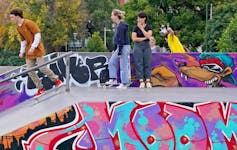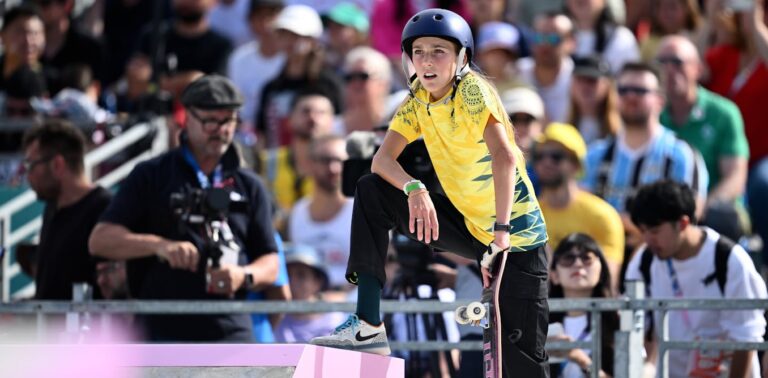While action sports were once a niche hobby, they continue to grow in popularity, especially among younger generations.
So why are more and more people getting interested in sports like BMX, skateboarding and surfing?
The popularity of the X-Games likely helped, but there are likely other factors at play as well.
For one, participants can take part in these activities in a way that suits their lifestyle and are free to express themselves outside of the rules, regulations and schedules found in traditional sports.
Action sports empower people to explore their potential and develop their skills and abilities without the rigid structures and expectations imposed by coaches or sports organizations.
These athletes don’t have to run laps to warm up or do push-ups as punishment, instead they forge their own path without a coach telling them what to do, when to do it and how to do it.
From rebellion to acceptance
When action sports first emerged in the late 1990s, athletes began challenging traditions and norms by embracing an anti-establishment, counter-cultural, DIY philosophy.
This was particularly evident at the 1998 Nagano Winter Olympics, when snowboarders such as Norway’s Terje Haakonsen boycotted the games due to demands imposed by the International Olympic Committee (IOC) on athletes and sponsors.
Some critics felt that the IOC had not respected snowboarding’s unique history and values, and several other action sports athletes have since spoken out against their sports being included in the Olympic Games.
Over the past few decades, participation rates in these sports activities have continued to rise both locally and globally.
In Australia, it is estimated that around 196,000 people aged 15 and over have taken up surfing and around 119,000 have taken up skate sports since 2019.

Scott Barber/AAP Images
As action sports become more mainstream, the narrative is starting to change.
Participants in action sports are not seen as rebellious, but rather are recognised for their positive values and behaviours – for example, the friendship, inclusivity and cooperation among skateboarders was highlighted at the Tokyo Olympics.
These are values that all sports can continue to learn from and benefit from.
Developing Independence: How Athletes Learn
This evolving environment has enabled researchers to investigate not only the values and motivations for sport participation but also how action sport athletes learn and develop skills.
Spoiler alert – these are often different to traditional learning methods and pathways.
Rather than being taught from a junior level onwards, as in most traditional sports, action sports participants tend to take responsibility for their own learning by going to skate parks or building their own ramps and obstacles out of dirt or snow.
In fact, some athletes, like BMX freestyler Logan Martin, have built their own freestyle parks in their own backyards.
This speaks to the flexibility, freedom and creativity participants have in when, where and how they choose to take part in sport.
In Martin’s case, it was an investment in his own professional development that paid off, winning a gold medal in Tokyo.
The role of peer coaching
In action sports, athletes often learn not from their coaches but from each other: They watch each other’s moves, discuss what works and problem-solve together.
This type of peer coaching boosts confidence and team spirit, especially when everyone has a common goal.
In these high-risk sports, athletes rely on their peers for advice and encouragement to successfully execute new jumps and tricks. An emotionally safe environment allows athletes to transform fear into courage, leading to learning and skill improvement.
Even at elite level, many action sports athletes learn differently – some have contact with performance support staff such as coaches, sports scientists, psychologists and nutritionists, but many do not.
For many action sports athletes, this often only happens once they have been recognised as a “potential podium contender”, meaning they have already met certain performance standards in addition to performing at international competitions.
Based on these guidelines, athletes will be provided with a scholarship and allowed to determine their own performance support management.
While action sports participants remain independent athletes, my research into the Australian BMX scene has shown that coaches are respected and accepted as “companions” who help them understand the world of BMX. Coaches created a positive and trusting environment where athletes could be themselves, share feedback and get the most out of their training sessions.
Out with the old and in with the new?
There’s no doubt that some traditional sports coaches and clubs have begun to shift their goals to meet the demands of the younger generation, but there are still many who can learn valuable lessons from the practices of action sports athletes.
Encouraging athletes to learn from each other, rather than relying solely on coaches, can enhance skills and personal development. Just like in action sports, watching teammates, discussing strategies and working together can improve performance.
Traditional sports can benefit from creating an environment where athletes feel supported, which in turn leads to them staying committed to their sport and continuing to develop on and off the playing field.
Coaches can achieve this by prioritizing building trusting, feedback-rich relationships between coach and players.
Coaches in more traditional sports can empower their athletes by giving them more control over their training, recovery and mental health, and this is where scholarships and individualized resources like physical therapy, psychology and nutrition can help.
So instead of the coach making all the decisions, why not let the players take the lead? What’s the worst that could happen?
If it’s safe in high-risk sports, it’s likely safe in traditional sports too.

